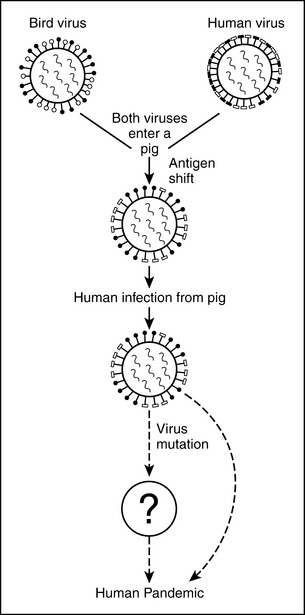INFLUENZA
Influenza viruses are usually quite host specific, and as such, are not considered zoonotic. Human influenza is a respiratory disease spread among people by aerosol droplets containing the influenza virus or by contact with surfaces contaminated with the virus. Wild migratory birds carry the virus but do not seem to become ill. Avian influenza is spread among domesticated birds, such as chickens, ducks, and turkeys that come in contact with secretions and excretions from infected migratory birds. From time to time, the avian influenza virus will mutate into a virus that can infect people and be spread from person to person easily. This is how pandemic influenza outbreaks are started.
ETIOLOGY: VIRAL
More than one virus can infect the same host cell. When this happens entirely new viruses may appear that have components of each original virus. For example, if an avian influenza virus and a human influenza virus co-infect the same host cell, portions of the two viruses can reassort to create an entirely new virus, not just a new strain. This is called antigen shift, and the results are much more serious than those seen with antigen drift. The host species has no previous immunity to this new virus. The dangerous part of this new creation is that it may have the pathogenicity of the avian influenza virus and the ability of the human influenza virus to pass from person to person. This may happen in swine and is how a pandemic could begin (Figure 21).
Stay updated, free articles. Join our Telegram channel

Full access? Get Clinical Tree



